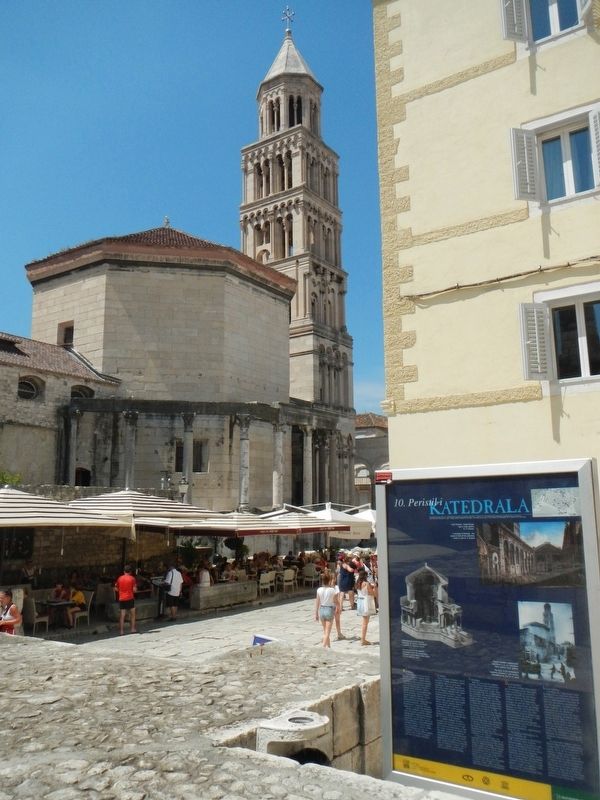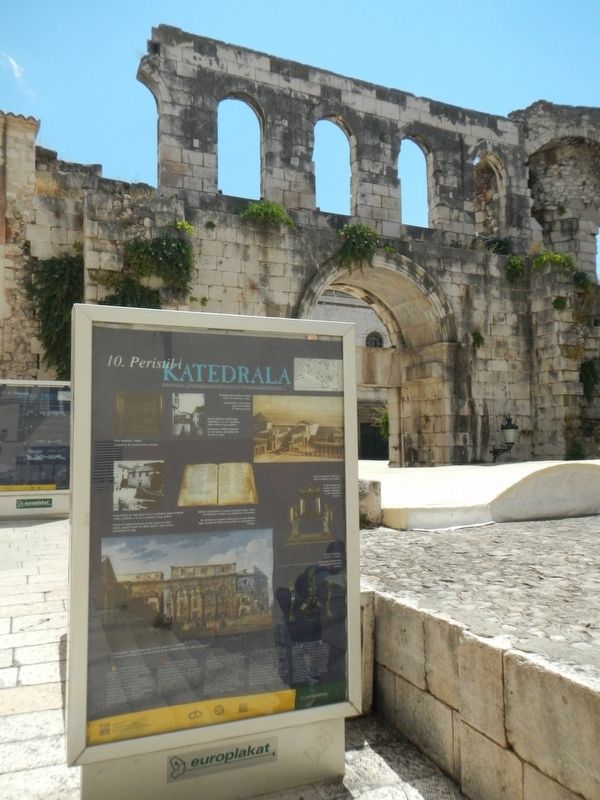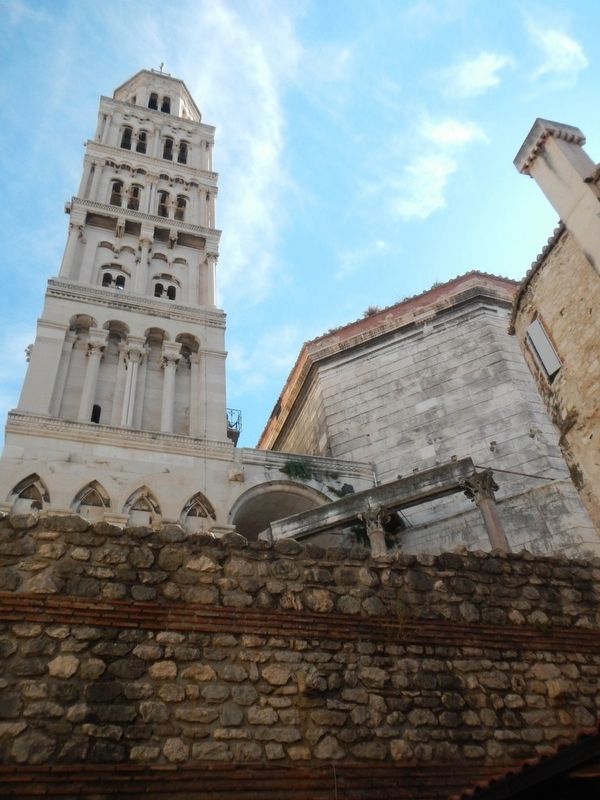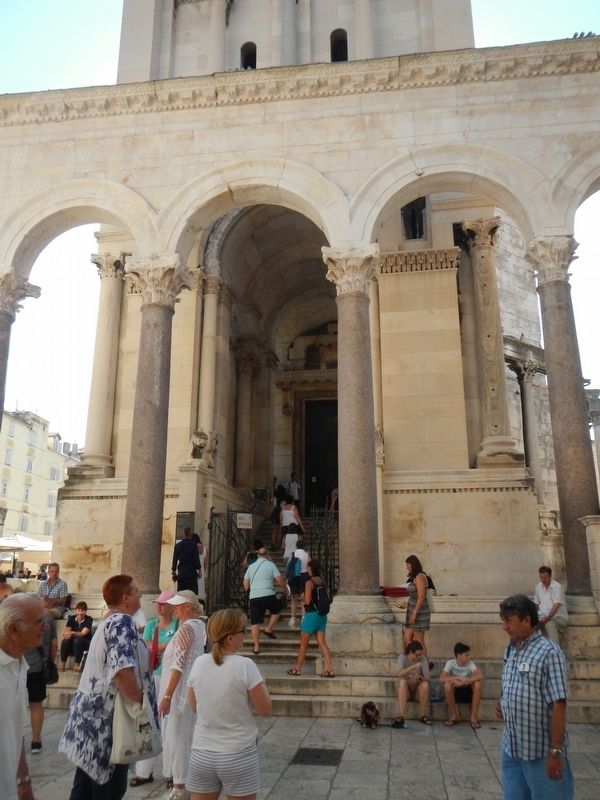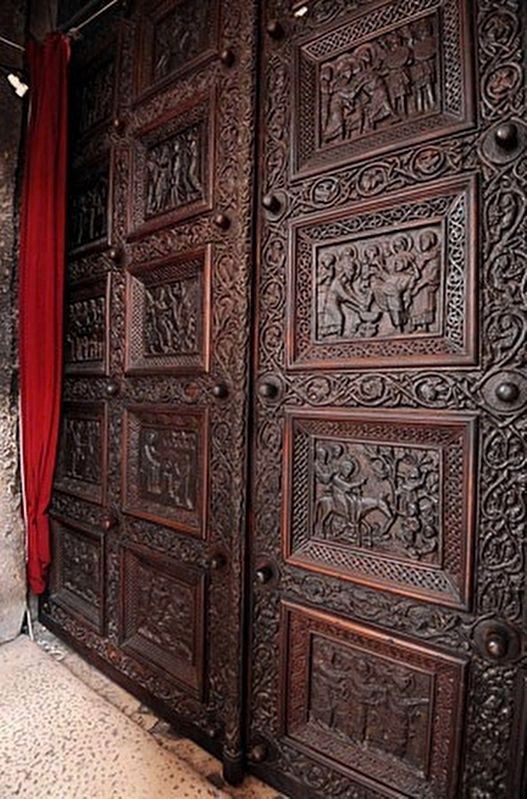Split in Opcina Split, Split-Dalmatia, Croatia — Central and Southeastern Europe
Peristil i Kathedrala
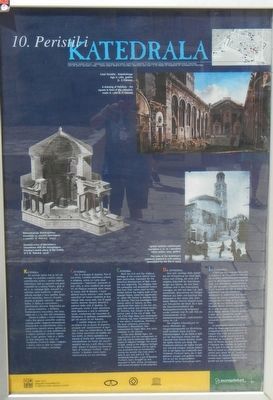
Photographed By Barry Swackhamer, July 29, 2018
1. Peristil i Kathedrala Marker, Side A
Captions: (top-right) A drawing of Peristyle - the square in front of the cathedral, made in 1782 (L.F. Cassas); (middle left) Reconstruction of Diocletian's mausoleum with the sarcophagus, Emperor's burial place, in the middle of it. (E. Herbrard, 1912); (bottom-right) The ruins of the Archbishop's residence (erected in 17th century, demolished by the fire in 1924). da Malano and an
(Side A:)
Both the civil and the religious heritage of the ancient Salona have been particularly important for the historical development of Split since the very beginning. The refugees from the conquered and devastated Salona fled from their native town to take shelter behind the mighty walls of the Imperial Palace, where the organization of urban life started to develop since 7th century. They had worshipped their martyr saints at Salona, so they transferred their relics to the new site, upon their arrival. One of those martyrs, St. Domnio, was chosen to be the patron saint of the city of Split. The cult of the Virgin Mary, once worshipped at Salona, has been followed here, in a new place of residence, therefore, the local cathedral, previously Diocletian's Mausoleum, was concreted to Virgin Mary very early, probably in 7th century.
In the early Middle Ages, the organization and management of each city, and its autonomy were mainly based on religious heritage. The Church of Split, owning to the religious heritage of the Salona diocese and its rights, was promoted into an Archdiocese during the synods that took place in Split in 925 and 928 A.D. The Archbishop was John, a son of Tordakat (Tvrtko?), born, brought up and educated in Split, whose sarcophagus with carved inscription is still preserved.
(Side B:)
The portal of St. Domnio's cathedral is decorated by the wooden doors, carved by Andrija Buvina in 1214. Inside the Cathedral there are the Romanesque pulpit, a valuable late Gothic sculpture by Benine da Milano and an Early Renaissance sculpture by George the Dalmatian, as well as many other valuable Baroque paintings. Close to the Cathedral there is the Cathedral Treasury where many relics, religious books, liturgical garments and other objects have been displayed.
Erected by Grad Split, Gradosro Poglavarstvo. (Marker Number 10.)
Topics. This historical marker is listed in these topic lists: Churches & Religion • Notable Buildings.
Location. 43° 30.494′ N, 16° 26.46′ E. Marker is in Split, Splitsko-dalmatinska (Split-Dalmatia), in Opcina Split. Marker is at the intersection of Poljana kraljice Jelene and Ulica Julija Nepota on Poljana kraljice Jelene. Touch for map. Marker is in this post office area: Split, Splitsko-dalmatinska 21000, Croatia. Touch for directions.
Other nearby markers. At least 8 other markers are within
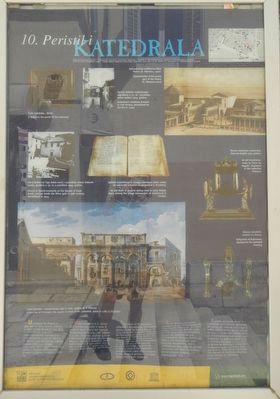
Photographed By Barry Swackhamer, July 29, 2018
2. Peristil i Kathedrala Marker, Side B
Captions: (top-left) A detail of the portal of the cathedral; (top-center) Archbishop's residence (erected in 17th century, demolished by the fire of 1924); (top-right) Reconstruction of the central part of the Palace (G. Niemann, 1910); (middle-left) Church of Saints-innocents on the Sqare of Good death, erected inside the Silver gate in 19th century, demolished in 1944; (center) An old Book of gospels dating back to early Middle Ages, among the oldest manuscripts on parchment in Croatia.; (middle-right) An old monstrance, made by Victor de Angelis, displayed in the Cathedral Treasury; (bottom-left) A drawing of Peristyle, the square in front of the cathedral, made in 1782 (L.F. Cassas); (bottom-right) Reliquaries of St. Domnius, displayed in the Cathedral Treasury.
Also see . . . Cathedral of St. Domnius, Split, Croatia -- Famous Historic Buildings. Located in the centre of Diocletian’s Palace in the heart of Split, the Cathedral of St Domnius was originally the Mausoleum of the Roman Emperor Diocletian (284-316) who died in Split in 316....In the 7th century Diocletian’s sarcophagus, which stood in the centre of the room, was removed, along with a number of pagan statues, and the building was converted to a Christian Cathedral by Bishop John of Ravenna. It is not known what happened to the sarcophagus but, as Diocletian persecuted the Christians, it is unlikely that it would have received any favourable treatment. The remains of a number of martyrs who died under Diocletian’s persecutions were brought to the cathedral where they were interned. (Submitted on January 9, 2019, by Barry Swackhamer of Brentwood, California.)
Additional keywords. Peristil i Kathedrala
Credits. This page was last revised on February 10, 2022. It was originally submitted on January 9, 2019, by Barry Swackhamer of Brentwood, California. This page has been viewed 150 times since then and 9 times this year. Photos: 1, 2, 3, 4, 5, 6, 7. submitted on January 9, 2019, by Barry Swackhamer of Brentwood, California.
